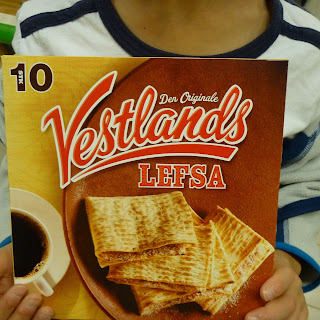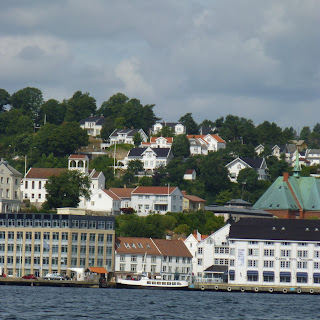The first day at Bolteløkka, the neighborhood public school,
was rough for the kids. By one pm, when school ended, their eyes were glazed over
and they appeared exhausted and dazed. New school, all new classmates and an
entirely new language of which they had no previous experience. I was quite worried that we had done the
wrong thing in sticking them into public school here.
But by the end of the third day, the kids had adjusted. They
like their teachers, have friends and seem happy. Addie has always liked
school. But Bram’s eagerness to go to school in the morning and his willingness
to do his homework in the afternoon are notable.
One thing Bram reports liking (besides recess) is the small class size. He
and Addie both have classes with only 11 other children. Their classes, like
much of Oslo now, are incredibly diverse. They are learning with kids from
India, Lithuania, Poland, Venezuela, Iceland, the horn of Africa, and China.
This is another reason Bram is happy. The child from China (Beijing) is a boy Bram’s
age. The boys speak Mandarin to each other.
As for the curriculum, what is not to like? They are
learning Norwegian, English and math. The emphasis is on activity. Addie
reports playing cards a lot. They are singing and dancing. A few days ago, their
teachers took them to the grocery store, where they helped them purchase picnic
supplies, including portable grills (quite common here). Then they took
everything to St. Hanshaugen, a large park near the school, and the kids
helped the teachers grill vegetable kebabs. After that, they stayed at the park
and swung on the fabulous rope swing there.
The kids get three recesses every day. They will have field trips at least every other week, although thus far, they have gone somewhere every week. (Next week, a ferry trip to Bgydøy island, where they will once again, grill their own lunch.) They
have arts/crafts each week and when they do, it seems to occupy a large portion
of their day. They will also have cooking class and woodshop.
Homework? It is not true that Norwegian kids do not
have homework, as had incorrectly been reported to me before we moved here.
They do have homework. But our kids consider it to be minimal—they write a few
lines in a diary every day. Presumably, the workload will increase, but it
still has a long way to go before they will consider it burdensome.
From a parent’s perspective, the operation of the school and
its curriculum is something of a mystery. Unlike at our school back home,
parents are not provided details about the doings at school and the curriculum.
The school has a website but it doesn’t seem to be used to communicate with
parents about kids’ homework. It is, in fact, hard to know what is happening on
a daily or even weekly basis. The teachers and administrators clearly do not
feel obliged, as do their counterparts do in the USA ,to keep parents informed.
There is no such thing as parent volunteers, much less a PTA. The school
handles everything, including provision of all school supplies. The only thing
we were told to make sure the kids had on the first day of school was a pencil
case. Nothing else, not even pencils.
There is no school cafeteria and hence no starchy, cheesy or
breaded entrees like our kids get back home. Maybe this is why I have not seen
obese kids here. Parents are told to send kids to school with a matpakke
(sandwich wrapped in plastic) and a piece of fruit and a bottle of water. They
are not to send anything sweet with the kids. Last Friday, the school provides
a special treat for the younger kids—brødskiver med brunost og syltetøy (slices of rye bread with brown cheese and
jam on top).
School begins at 8:30 and lets out as early as 1 pm on some
days and as late as 2:15 on others (and at other times in between as well).
There is a weekly schedule that comes home with the kids every Monday. But that
does make it hard to know when to pick them up on Monday afternoon! Asking
doesn’t always produce accurate information, we’ve found. And even when we know the schedule, we’ve
found that it is not followed strictly. Many days, the kids are let out as much
as 10 minutes early, and occasionally, they emerge 10 minutes late. The
imprecision doesn’t seem to bother anyone here.
And there is no great concern here over what we would refer
to as safety issues. At home, we submit
to background checks if we will be visiting the school. Nothing like that here.
We have “secure” buildings with locked doors during school hours. Nothing at
all like that here. At home, we check in with the front desk if we wish to go
to a classroom. Not here. And at home, in
our experience, children are released in the afternoon to their parents or an
approved adult, or they are placed in school-run after-hours programs, such as
Explorers Club, that provide adult supervision. I asked the principal of Bolteløkka about this—was
there some activity I could place the kids in if there were afternoons when I
could not get to school to pick them up? This elicited a quizzical look. After
school, the kids go to the playground to play, she explained. Was this supervised
play, I asked, and what does it cost? Now, she smiled a bit and repeated that
kids just play on the playground after school until their parents pick them up.
Finally, she responded to my disbelief
by saying, “This isn’t like America. We are not constantly worried about our
kids’ safety.” Clearly not.
There does not appear to be such a thing as a “helicopter
parent” here. Or if there is, they don’t sent their kids to Bolteløkka. The
school is 6 blocks from where we live and it takes us about 10 minutes to walk
there. This is another highlight of the situation, from Addie and Bram’s
perspective, and may account for their happiness. Turns out that they are just as tired as I am
of the 20-minute schlep on the 62 Crosstown every morning and afternoon. They
love walking to school here and they are also eager to walk to and from school
ALONE, without a parent. Many kids here do this. When I was puzzling over what
kids with working parents do after school, the principal explained that those
who don’t choose to play on the playground walk home on their own. It is common
apparently to give kids a key to the house and allow them to be alone until
their parents get off work. Addie and Bram are all for this, of course. For
now, in this one respect, we won’t adopt Norwegian custom.



































